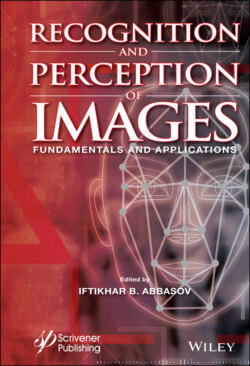Читать книгу Recognition and Perception of Images - Группа авторов - Страница 16
1.1.3 Vertebrate Eye Anatomy
ОглавлениеAnatomically, the eyes of all vertebrates have a similar structure. From fish to mammals, the eyes of all vertebrates have a photosensitive layer, called the retina, and a lens to focus the image on the retina. Figure 1.1.5 presents a vertical section of the human eye.
Figure 1.1.4 Structure of the compound eye of a fly.
The eyeball is located in the deepening of the skull, and has a spherical shape with a diameter of about 20 mm. Outside the eyeball is covered with sclera, a white opaque sheath about 1 mm thick. On the front surface of the eye, the sclera enters the transparent membrane – the cornea. The curved surface of the cornea provides the necessary refractive index (refraction) in the optical system of the eye. It has no blood vessels, it receives nutrients from the capillaries and liquids surrounding it. Light rays are refracted on the cornea and focused by a lens on the retina, located on the back of the eyeball. The vascular membrane of the eye is associated with the sclera, has a thickness of 0.2 mm, and consists of blood vessels that feed the eyes.
The anterior part of the choroid is a colored concentric disc called the iris. From a biological point of view, the iris contains a landscape filled with rings, dashes, specks; each person has more than 200 individual distinguishing features. The iris is a disc-shaped, colored membrane consisting of two smooth muscles, located between the cornea and the lens [Fershild, 2004].
Pigmentation of the iris is determined by the concentration of melanin inside the iris. The main function of the iris is to regulate the amount of light that enters the eye. In low light, the iris contracts, and the pupil increases in the form of a round black hole. In bright light, the reverse process occurs; the iris is stretched, and the pupils are narrowed. The change of the pupil is controlled by two oppositely directed iris muscles – the sphincter and the dilator of the pupil. In an adult, the diameter of the pupil varies from 2 to 9 mm; this leads to a change in the area of the pupil of more than 20 times.
Figure 1.1.5 Vertical section of the human eye.
Usually the pupil responds to changes in illumination reflexively; bright irritating light causes Witt’s reflex (described by physiologist Robert Witt in 1751). Witt’s reflex is used to diagnose diseases of the central nervous system, as well as to determine signs of life in a person during rescue operations.
The human pupil is round, but the pupils of some species may have a different shape. The pupils of the cat’s eyes are in the form of a vertical slit, and nocturnal animals (including crocodiles) have such pupils. Nocturnal animals also have a retinal layer, called tapetum (lat. tapete – carpet). It reflects part of the light that enters the eye. It is the reflection of light from the tapetum that causes the eyes to “glow” at night. In the dark, we notice well the “glowing” eyes of domestic cats.
A similar effect in the human eye is known to us as the “red-eye effect” when taking pictures with flash. In low light, the pupil expands; despite the speed of the reaction (about 0.25 s), it does not have time to narrow during an outbreak. In the “anti-red eye” mode, a warning flash is provided in the cameras to constrict the pupil.
The lens divides the eyes of vertebrates into two parts. The front part is filled with watery moisture; it helps to maintain the shape of the eye and is involved in metabolism in the cells of the cornea. The large back end behind the lens is called the vitreous body and consists of gelatinous protein. These transparent substances allow you to hold the lens in a certain position. The elasticity of the eyeball ensures its resistance to mechanical damage. The refractive index of liquids inside the eye is approximately equal to the refractive index of water; they are slightly higher for the cornea and lens. Unlike constantly renewing aqueous humor, the vitreous remains unchanged. Sometimes pollution is indicated by randomly “floating” small “threads” in front of the eyes.
Experimental confirmation
The existence of a blind spot can be proved using Figure 1.1.6. After completing a series of simple steps, you will see that the visible image suddenly “disappears.” Close the left eye and place the picture at a distance of about 25 cm. Focus the right eye on the cat, while slowly approaching and moving the drawing. At a distance of approximately 15 ÷ 30 cm (depending on the scale of the image) the bird will disappear and the cage will empty. When the drawing is at a certain distance from the eye, the image of the bird in the cage will fall on the blind spot and disappear completely. However, despite the disappearance of the bird, you will not see a white spot; instead of it the area will be filled with cage bars [Abbasov, 2016].
Figure 1.1.6 “Cage without bird”, the scheme for the detection of “blind spots”.
